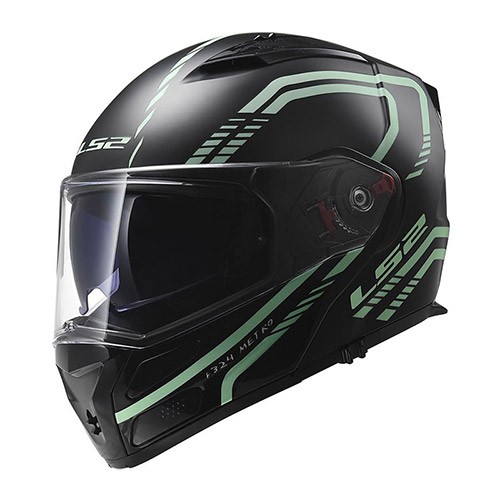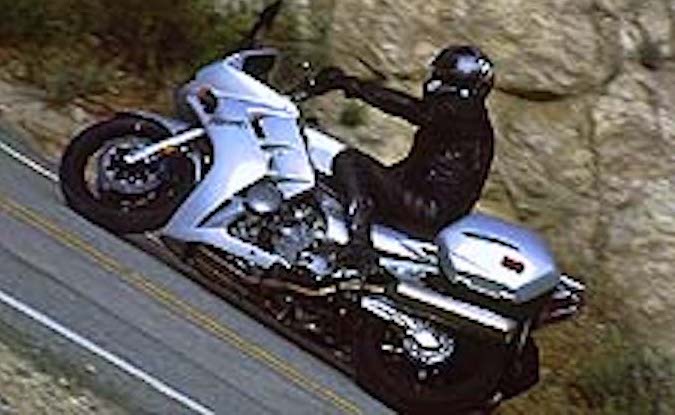All we learn from history, goes the current cynical wisdom, is that we learn nothing from history. Then again, maybe we do? For instance, I just learned this morning that Yamaha is still stamping out the FJR1300ES 20 years after the original 2002 FJR1300 hit our shores. Well, they’re still selling them anyway. I remember FJ1100 very fondly, FJ1200 was the tool for inhaling great draughts of western landscape at ludicrous speed… all before this first liquid-cooled FJR blew our moldy sport-touring socks off. (Note Minime’s acting out by spelling three of four names wrong in only the first 2.5 lines of copy. Is there an Editor in the house?)
Torrance, California, May 3, 2002 — When I was a kid I used to play make-believe with my friends. I’d be Audey Murphey or maybe Roy Rodgers while they’d be the outlaw Jessie James or Billy the Kid. They were good times, though I can’t recall a time in recent memory when I’ve played make-believe again, until last Wednesday night.The MO Test Squadron was humming along Highway 14 headed south, having just completed a number of runs out at the drag strip in Palmdale for our Open Twins story. I had along Yamaha’s newest Super Sport Tourer, as they refer to it, and got this eerie feeling about me as the sun was setting. It was surreal, the silver FJR humming along beneath me, rolling at a steady 80 miles an hour, window adjusted to its fully upright position and I tucked warmly inside some Kushitani leathers watching the sun set over the mountains in the distance. But something felt amiss. Something just felt wrong and was throwing off the circadian rhythms of this world.
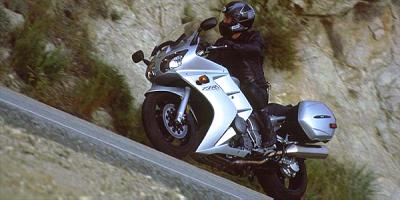
I was headed home, and I knew it, and I was only coming back from Palmdale. That was depressing me. As good as the bike felt, Palmdale was an insult to its intentions. It needed to be coming back from somewhere else, someplace a lot farther than a little desert town just 80 miles away. It needed to be coming home from a trip back to Arkansas to visit my grandparents. And so it was. I played make-believe and convinced myself of exactly that, if only for a few moments. But they were precious moments when everything fell into place, and the FJR made perfect sense.
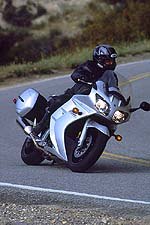
From the start, Yamaha’s engineers had it in their heads to build something that was the perfect blend of “super sport performance with long-distance luxury.” What they gave us, it seems, is nearly a damn fine big-bore sportbike in the manner of the old YZF1000, but wrapped in the bodywork of a damn fine light touring rig, if you consider 620 pounds light.
Though it looks like any modern (good-looking) sport-tourer, Yamaha’s new FJR1300 is quite impressive when you emphasize the sport part of the equation.
From a distance, the FJR looks serious, especially with its color-matched standard hard bags and the electronically adjustable windscreen in the up position. Closer inspection reveals some seriously thoughtful attention to detail like an oil filter that’s right there on the lower left side of the engine, available for easy parking-lot oil changes (of which I’ve done many) without the removal of any bodywork whatsoever. The drain plug’s easy to get to, of course, as is the nifty little two-position preload adjuster located just under your left thigh once you stop looking at stuff and get on board the thing.
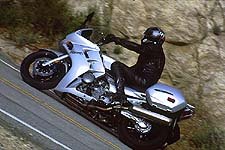 With the tightly spaced gearbox and wide spread of power, we had our choice of three gears per corner, it seemed, and so we were always right in the thick of things.
With the tightly spaced gearbox and wide spread of power, we had our choice of three gears per corner, it seemed, and so we were always right in the thick of things.
Chasing Johnny up our usual test route out to the desert, I tucked in right behind him and the Mille-R, trying my best to keep him just a few feet ahead of me. It’d be extra sweet to show him a wheel, I thought, as I hustled the FJR around corners, pushing as hard as I dared. The brakes were excellent, as they should be, pulled directly from Yamaha’s own YZF-R1. He wasn’t going to gain time on me with the brakes, that was for sure. The fuel-injection was feeling seamless too, as was the rush of power to the rear wheel, unimpeded by an excellent shaft-drive system. I’d have no excuses to pull, I thought, re-focusing my attention on the Mille-Rs tail section, now canted at more of an angle than I’d seen it all day.Shoved down into a corner, the FJR protested with a bit of a bob-and-weave of the back end as the pegs found their way down into the pavement, momentarily dragging the standard center-stand. I remembered, mid-corner, what Yamaha’s PR Manager had said to me as I picked up the bike: “Most people like it with the pre-load set to Hard.” D’oh! That’s just what I needed to close the gap, I thought, since I knew I had the lever in the Soft position for the freeway part of the traffic-heavy flog that made up the majority of our journey to this point. I was losing time mid-corner, but I wasn’t giving up, and the FJR wasn’t either.
With the tightly spaced gearbox and wide spread of power, I had my choice of three gears per corner, it seemed, and so I was always right in the thick of things heading out of any given bend. With the throttle dialed on, the back end squatted and settled down, managing to get the front end very light at corner exits on occasion (128 rear wheel horses will do that). Sure, I was working the FJR’s arse off, but everything was so easy for me. All the controls and inputs were effortless. It was a joy to watch John and the Aprilia working right in front of me, only slightly pulling away once things got Stupid Fast and well into a realm of performance not many FJR owners are likely to tread, though it’s nice to know the bike is capable of taking you there–and back.
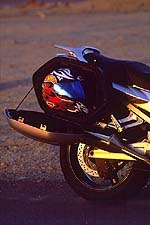 The standard hard cases rival BMW’s luggage for their cleanliness of design and ease of use. Of course, they easily swallow a full-face helmet, which is always nice.
The standard hard cases rival BMW’s luggage for their cleanliness of design and ease of use. Of course, they easily swallow a full-face helmet, which is always nice.
At the photo spot just over the back-side of the road we stopped to swap riders. I dis-mounted and unpacked my camera gear and some Marlboros while photo boy Peter Jones got used to the FJR’s basic feel. After stepping from the RC-51 and its track-dialed suspension, he immediately came back complaining of the wallowy back end. Ah! I said, how ’bout we just flip this lil’ lever here and send you back out? Done deal, and off he went with a stiffer shock beneath him.After we got done with the photos, he came back in to report what I’d find out later on myself: with only two pre-load positions available, there’s not as much room for adjustment as we’d like. There’s no ramped adjuster or even a threaded type of adjuster anywhere under there. You get two positions to choose from, soft and not-as-soft. This is especially annoying since the excellent front forks are completely adjustable, even though we never needed to touch them. Sure, the Hard pre-load setting may be in the ballpark for most of your riding, but what about when you’re loaded down with luggage or a passenger on back or, God forbid, both?
Back under way we were headed down the mountain and out to the Interstate where this bike is really made to shine. With any luck we’d stop our incessant bitching about the obvious lack of eight-thousand different clickers out back and get back to the business of riding the thing as we should.
Pulling onto the freeway I knew full well that my compatriots on the sport twins must be getting low on fuel, but I didn’t care. Surely they’d be able to make it 20 miles or so to the next gas stop. And if not, I had enough left in the FJR’s 6.6 gallon tank to fuel up the others enough to get them back on the road. With just over 100 miles showing on the FJR’s trip-meter, the fuel gauge was showing things only half empty. (Okay, I’m a pessimist. So what?) I just rolled onto the freeway and thumbed the rocker switch on the left control cluster that magically raises the wind screen, placing me in serious high-mileage mode.
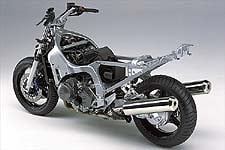
In it’s lowest position the bike looks, from the saddle, just like any good sport-tourer should. The fairing puts the windblast at upper-chest level, leaving the helmet in a nearly buffet-free flow. With my 6’2″ tall frame, however, I was in the mood for complete comfort and only the tallest position would suffice. This placed me in the sort of negative pressure zone that finds a bit of added pressure on the wrists despite the perfectly comfortable upright seating position as you actually get air flow from behind you. I found that with just a little bit of a slouch in my posture I could keep my helmet completely out of the flow of air up top while minimizing any other unwanted wind forces around my body. The ergonomics even suit my lanky frame just fine, though a little bit more legroom wouldn’t be an unwelcome addition.
All-new from the ground up, Yamaha’s new FJR was designed to be the perfect blend of “super sport performance with long-distance luxury.
Out on the highway, that smooth flow of power we felt in the twisties comes through as one of this machine’s shining points. The twin counter-balancers do a remarkable job of damping out any vibes before they find their way to the hands, butt or feet. In fact I’d venture to say this is the smoothest in-line four-cylinder motor I’ve felt maybe ever. Rolling along at an indicated 70 mph the engine is ticking over at 4,000 rpm, with an additional 500 rpm generating eight more mph. Despite the smoothness of the motor, however, it feels like it wants me to grab another gear so we can both motor down the highway, loafing along whilst we approach our destination at roughly 80 mph. But it’s not to be.
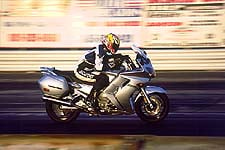 Hackfu, on board the FJR at the drag strip, on his way to a corrected 11.2 second E.T. at 118.8 mph. Tank bag included.
Hackfu, on board the FJR at the drag strip, on his way to a corrected 11.2 second E.T. at 118.8 mph. Tank bag included.
The transmission, you see, is only a five-speed unit. There is no sixth gear to notch into. This is especially frustrating since the first few gear changes seem like they’re tight and perfectly spaced for a six-speed box. But when you get rolling, the sixth gear is missing. Say again: D’oh! When starting from scratch, and especially knowing the bike would see tons of Autobahn use, this is a surprising flaw in an otherwise nearly flawless package.The up-side of this otherwise nagging trait, however, is that a twist of the wrist while cruising along at 75 mph will see nearly 70 horses and 90 foot pounds of torque generated at the rear wheel. Just the stuff you need to squirt past that lumbering Milk Truck of an SUV in front of you, even with your fat girlfriend on back, pulling a two-horse trailer, without downshifting.
So, at the end of it all, we have what’s sure to be an absolute hit with buyers. The engineers who designed this newest iteration of the venerable FJR line certainly paid a lot of attention to detail, things that will make life and thousands of miles with the 1300 all the merrier. There are a few things they could have maybe done better, but then what would you have left to fiddle with? You can only polish a bike so many times before it gets that annoying waxy build-up.
Yamaha’s new FJR is fast, smooth, comfortable, adjustable, sporty, toury, and just a bit sexy, all at once. If you can find a dealer with one on the way, this is a highly recommended ride we suggest you go take a long, hard look.
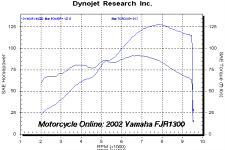
Become a Motorcycle.com insider. Get the latest motorcycle news first by subscribing to our newsletter here.
